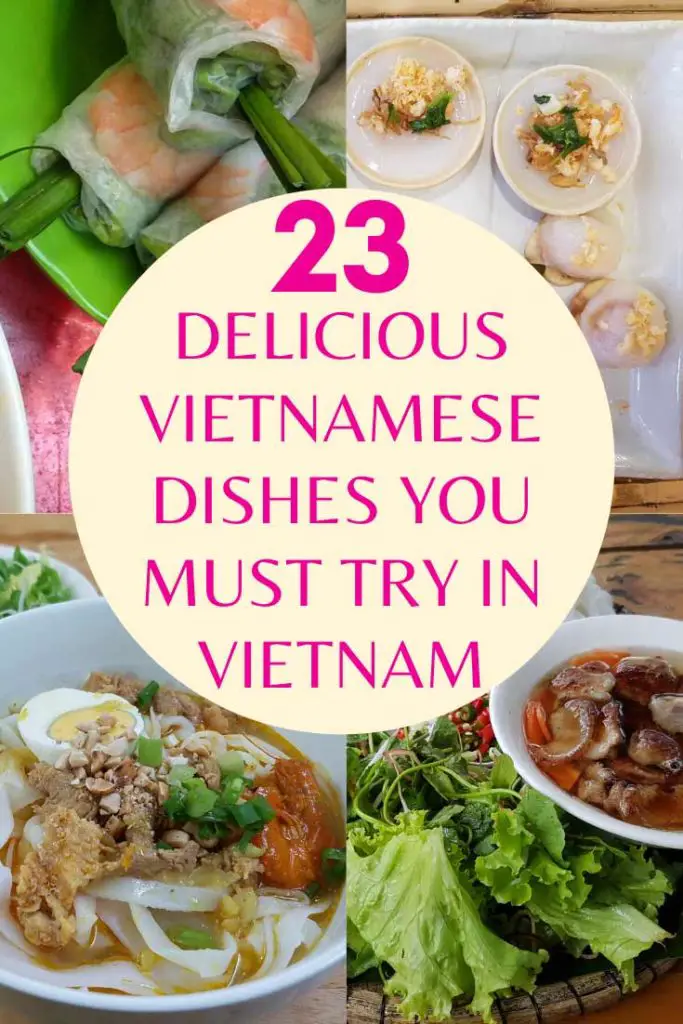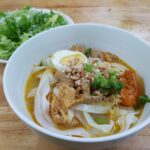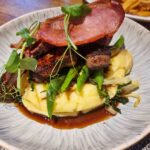
Vietnamese food is one of my favourites in the world. I can still remember the first pho soup I had during my first trip to Vietnam. It was early morning, and I just arrived in Hanoi after a long overnight train from Nanning, China. After dropping my bags at the hostel, I decided to go for a walk around the city, to see it waking up. The sun was rising, the sky was pink, and the parks were full of locals practicing tai chi. It was fascinating. I sat down at a tiny table, on an even tinier stool, at one of those side street improvised restaurants, where an old Vietnamese lady was cooking a big pot of pho. The first spoonful of broth was so full of flavour, so many different spices and herbs combined to create the perfect taste. Even now, thinking about it, I can still feel those flavours in my mouth. If you are searching for the best food in Vietnam, then you have come to the right place. The country has such a flavoursome cuisine, with dishes created using the yin and yang principle – fried foods must be balanced with fresh ingredients. The fried spring rolls are always wrapped in salad leaves, the soups are always topped with fresh herbs. No matter which part of Vietnam you are travelling to, be it the Mekong Delta, Mui Ne, Hoi An, Ho Chi Minh City, Hue, Hanoi – you will always find specific local dishes that will make you want to return to Vietnam over and over, just for the food.
So, without any more introduction, let’s see what to eat in Vietnam. Here is a list of the most delicious dishes, the best food in Vietnam.
Pho

Any trip to Vietnam without trying Pho would be incomplete. For some people (including us) eating Pho is one of the irresistible magnets that draw us back to Vietnam again and again. Perhaps we should admit to a touch of Phomacy 😉
So, what is Pho? It is a Traditional Vietnamese clear meat and noodle broth. Pho can be made from either beef or chicken and it is served with fresh rice noodles which can often be cooked very quickly by dipping them into the soup itself. And Pho can be eaten for breakfast, lunch, or dinner.
We discovered Pho while exploring Hanoi with kids. By that time, we had already spent some time in Ho Chi Minh City, but Pho is less popular there in the South. Perhaps it originated in the north because of the cooler climate where a bowl of chicken broth with noodles is more appreciated.
in Hanoi on every street corner, you can see great 60 litre vats full of steaming Pho ready to be served.
During one of our trips we decided to find the perfect Pho. And so for a few days we ate nothing else. Despite that binge, we still love it. We have even attended cooking classes to learn how to cook the perfect Pho. Of course, we try to make it at home too, but it never seems to taste as good. There must be some secret ingredient besides chicken, water, onion and rice noodles. Or perhaps Pho just has to be eaten in Vietnam.
Fresh Spring Rolls – Gỏi Cuốn

Fresh spring rolls are a Vietnamese icon. Along with pho and banh mi, this fresh and tasty appetizer one of the country’s most well-known dishes and is beloved by locals and outsiders alike.
Called gỏi cuốn in Vietnamese, spring rolls are popular as an appetizer and are often shared among large groups. Even though today they are synonymous with Vietnam, fresh spring rolls, like many popular dishes in Southeast Asia, spring rolls are thought to have been brought to the country by Chinese immigrants.
Unlike their deep-fried and crunchy cousins, fresh spring rolls are served chilled or at room temperature. Typically, they’re stuffed with pork or shrimp (or tofu in place of meat), fresh herbs, and sometimes glass noodles or fresh veggies. They are then wrapped up in rice paper, which gives them a slightly chewy exterior.
Unlike fried rolls, which can be heavy and greasy, the flavor profile of spring rolls focuses on fresh herbs and dipping sauces that pack a punch! Peanut sauce is a popular dipping option as is a bright and zingy sauce that contains fish sauce and a bit of spice.
If you’re traveling around Vietnam, you’ll be happy to know you can find spring rolls all around the country (though the local name for them differs a bit from region to region). It’s even possible to learn how to make them in a cooking class. While the technique of rolling them takes a bit of practice, they are actually very simple to recreate, and you can add whatever ingredients strike your fancy.
Fried Spring Rolls – Cha Gio

The Vietnamese fried spring rolls are present on pretty much every menu at every restaurant. They are popular at street food stalls, at established restaurants, in cooking classes and at homestays, where the locals are cooking them for their guests. I would say that together with pho, the fried spring rolls are the most popular best food in Vietnam.
The inside of the spring rolls usually has a mixture of pork, shrimp, cabbage, mushrooms and shallots, all tiny diced. The mixture is wrapped inside rice paper and them deep fried until it reaches that crispy, delicious consistency.
The fried spring rolls are served with salad leaves, fresh vermicelli noodles and herbs such as mint, sweet Thai basil and cilantro. They are usually dipped in a traditional dipping sauce called nuoc cham, made with fish sauce, water, bird’s eye chili, garlic and sugar.
Bún Chả

Bún chả is a traditional Vietnamese street food staple originating from Hanoi, Vietnam’s capital city. It hit the international radar when Barack Obama and Anthony Bourdain rolled up their sleeves to dip white rice vermicelli (bún) and herbs into little bowls filled with vegetables and fatty pork (chả) drenched in Nuoc Cham (Nước Chấm), a sweet, slightly tangy fish sauce mixed with garlic, chili, sugar, and lime juice.
In a nutshell, Bun cha is a charcoal-grilled pork dish served with cooked vermicelli rice noodles and a mountain of fresh herbs and salad greens.
The pork comes in meatball and square slices, and served in a small bowl of sliced chili peppers, alongside with a heaping plate of bean sprouts, coriander, and basil
While there are many many variations, depending on regional tastes and preferences, the main difference between bun thịt nuong and bun cha is in the preparation of the meat. Furthermore, the ingredients of bun cha like grilled pork, rice noodles, cilantro, bean sprouts, lettuce, and Nước Chấm are presented separately.
If you feel really hungry, you can get bún chả served with a side of Vietnamese-style imperial rolls (Nem Rán). The combination is delicious so don’t miss out on ordering a side of nem with your bun cha. Just make sure to mix everything together before you eat!
Bánh Mì
By Caroline from CK Travels

Bánh Mì is an iconic French-Vietnamese street food dish and is consistently ranked as one of the world’s best sandwiches. A Banh Mì consists of a toasted french baguette filled with savoury ingredients such as pork belly, bbq pork, sausages, pâté or ham. This is then combined with sprigs of coriander and vegetables such as radish, pickled carrot and cucumber, and a dash of chilli sauce! The combination of ingredients is absolutely heavenly and explains why some popular bánh mì restaurants always have very long queues (such as Banh Mi Phuong in Hoi An).
The dish originates from the southern part of Vietnam and is a product of the French colonization. The history of the bánh mì differs, but most people agree that the introduction of the baguette into Vietnam was in the mid 19th century when it was part of French Indochina, and it soon became a popular breakfast / lunch snack in the early 20th century. During the 1950s, a more Vietnamese version of the sandwich developed in Saigon, and it became a popular street food all over the country.
The bánh mì is very cheap to purchase – usually around $1 for one baguette. In all the major cities you will find street cart vendors and restaurants selling them, so the dish is not hard to find.
Bun Bo Hue

Bun Bo Hue is a dish that originated in Hue. While you can find it outside of the city, it remains pretty exclusive to Central Vietnam, and it is one of the most iconic dishes to try in Hue.
This broth-based noodle and beef dish is quite similar to the better-known Vietnamese dish of Pho. But Bun Bo Hue is usually much spicier than pho, and is definitely a unique dish!
The main ingredient of Bun Bo Hue is a light, spicy broth which is heavily fragranced with lemongrass. Vermicelli noodles, sliced beef, balls of crab meat, offal meatballs, spring onions, chillies, and coriander are all added to create a rich, tasty meal that’s full of flavour. Like pho, it’s usually eaten for breakfast, so you’ll find big queues at the most popular stalls every morning!
Every restaurant seems to have its own variation of Bun Bo Hue. Many also add a cube of congealed pig’s blood, which really adds to the flavour of the dish. Sometimes they don’t add this for tourists, so be sure to ask for it if you want the true Bun Bo Hue experience! Many people agree that the best Bun Bo Hue comes from Quan Cam, which is where I tried it. The restaurant is small and very casual, but it was rammed with locals when I visited – usually a good sign if you’re looking for authentic Vietnamese cuisine.
Banh Xeo

Banh Xeo is a rice flour pancake filled with various toppings and herbs and is one of the most popular dishes in Vietnamese cuisine. The name translates to “sizzling cake,” and refers to the enticing sound of the batter being poured onto a scalding hot skillet.
Stuffings can be regional, but commonly include pork, shrimp, green onions, and bean sprouts. Often, people confuse it with an omelette because of the yellow color. The yellow actually comes from turmeric: there are no eggs in the dish! Like many Vietnamese dishes, it is served with a heaping serving of greens and herbs, including lettuce, mint, and Thai basil. The crispy, lace thin pancake pairs impeccably with the savoury fillings and the fresh herbs and greens. In three words, Banh Xeo is crunchy, savoury, and fresh. In my opinion it makes a perfect hangover food.
The origins of Banh Xeo can be traced to central Vietnam, although it quickly spread to North and South Vietnam. Today, Banh Xeo can now be found all over the country, from street food stalls to upscale restaurants. I highly recommend you try this crunchy, rich, and savoury pancake: it really highlights the brilliant tastes and textures of Vietnamese cuisine.
Cao Lầu
By Heather from RaulersonGirlsTravel

Vietnam food surprised me with its exotic street food of Lobsters, Octopus, Squid, and even Frog Legs. I wasn’t sure I would find anything that I would like. That is until I found out about Cao Lầu a specialty of the Ancient Town in Hoi An. The brown noodles are mixed with thin slices of pork (cooked in the traditional Chinese method known as char siu), fresh green vegetables, and crunchy croutons. It also includes a homemade sauce made from pork, shallot, and soya sauce, creating a fusion of flavours that is impossible to forget. Once you have tried Cao Lầu, you will want to keep ordering it at every place that offers it.
The uniqueness of the dish is that the noodles are made by using special tree ash in Hoi An, which gives the noodle its brownish-color, and the water is from a Ba Le well that is over 1000 years old. The recipe in making these noodles is kept secret by a few families living in Hoi An, which makes it difficult to find this dish outside of the city. The dishes can be found at most of the restaurants around the Old Town in Hoi An, and my personal favourite is the Noodle House. You can get a variety of noodle dishes there that are large enough to feed a family. I did order Cao Lầu at multiple restaurants, and each one had a slightly different version of the crouton, but the flavour was the same, and they were all delicious!
Cơm Gà

The name “Cơm Gà” means “chicken rice”, and those are in fact the two main ingredients of the dish. There’s a particular version of Cơm Gà that has become very popular in Hoi An, and so you’ll often hear it referred to as Cơm Gà Hội An. But the original version of this dish is from Hainan, an island in the South China Sea that lies in between Vietnam and China but belongs to China. Given the many Chinese traders who settled in Hoi An over the centuries, it’s not surprising that they brought some of their culinary traditions with them.
The main difference between the Hainan version and the Hoi An version is that in Hainan the chicken meat is left whole, while in Hoi An it is shredded and mixed with onions and various herbs to create a salad. That salad is then served over rice that’s been cooked in chicken broth. It’s served at many stalls and restaurants throughout Hoi An, although foreigners are often given a “tourist-friendly” version of the dish. The one eaten by locals will likely have various internal organs or congealed blood added in.
But if you’re not into eating body parts of any kind, the many Buddhist vegetarian restaurants in Hoi An make an incredibly realistic veggie version. How they recreate the shredded texture of the meat is a carefully guarded secret, but vegetarian and vegan travelers in Vietnam are sure to love this plant-based version of Cơm Gà.
Bun Bo Nam Bo

Bun Bo Nam Bo is sometimes translated as a cold beef noodle salad or stirred beef vermicelli, but no matter what you call it it’s delicious!
The origins of the dish are a mystery. Its name literally means “Southern Beef Noodles,” but historians don’t know if it originated in the south around Ho Chi Minh City or if it was created in Hanoi but named after a style of serving noodles that was more popular in the south at the time.
Today the dish is served all over, but there are differences between how the dish is prepared in the north versus the south. Additionally, the exact recipe used in each restaurant tends to be a closely-guarded secret, and locals know which Bun Bo Nam Bo establishments to frequent.
The broth is a simple fish sauce and water, and the great flavor comes from the dish’s signature protein, beef, mingling with the sauce. Besides the beef, noodles, and fish sauce, Bun Bo Nam Bo also includes lettuce, cucumber, fried shallots, crispy bean sprouts, cilantro, and peanuts.
Proceed with caution if you have a peanut allergy. While they add the peanuts last as a garnish, if your allergy is life-threatening then I would skip this dish since the peanuts are thrown around a bit.
If you want to make this at home, pick up some fish sauce while you’re here to bring back as one of your souvenirs from Vietnam.
Mi Quang

Mi Quang is a rice noodle dish that comes from Central Vietnam. It is popular for breakfast at home in places like Hoi An, Phong Nha, and Da Nang.
Like many Vietnamese noodle dishes, it includes a variety of textures, and you could say it is part soup, part salad. Mi quang often comes with shrimp, pork, vegetables, roasted peanuts, fresh herbs, and sometimes quail eggs or sesame rice crackers on top.
The mi quang noodles are thicker than vermicelli, made from rice, and purchased fresh from a local market.
This dish is made with different variations but always includes a bit of broth to tie it all together. We’ve had it made with a pumpkin base or with saffron and tumeric, both giving it a golden color. If you get one with good flavor, it can be really delicious. Instead of ordering from a restaurant, try asking a homestay host or local friend to make it from their family recipe.
Hu Tieu Nam Vang

Hu Tieu is a traditional Vietnamese breakfast dish that is served either as a noodle soup or as a dry noodle salad, with the broth served on the side.
Originating in southern Vietnam, the Mekong Delta in particular, Hu Tieu is a close culinary relative of the popular Cambodian dish, Kuy Teav, and can be found in all markets, road side stalls, and dedicated Hu Tieu restaurants.
The soup broth is made by slowly cooking pork bones, with a flavour that is deliberately subtle, with no signs of any spiciness sometimes associated with Vietnamese soups. Additional flavours and textures are added by the diner using the accompanying herbs, lettuce, beansprouts, chillies, and limes.
If ordering the salad version, the noodles are mixed with a combination of oyster sauce, soy sauce, and sugar, and can be quite sweet, particularly in the Mekong.
One slightly confusing aspect when ordering is that there are three types of noodles to choose from – the traditional Hu Tieu noodle, the Pho noodle, or a yellow egg noodle, or a combination of the three if you wish, which seems the most popular.
There are a number of regional varieties of Hu Tieu in southern Vietnam, but the taste profile match each other very closely. All come topped with pork, with other available toppings including shrimp, pork liver, fried garlic and caramelised shallots, depending on the vendor.
Hu Tieu, in both the soup and salad version, is a light and refreshing dish that is a perfect start to the day.
Banh Beo

With more than two thirds of Vietnam’s delicious dishes hailing from the ancient city of Hue, the town has a rich history of scrumptious fare, stretching back as far as the early 1800’s. But, in a city that’s renowned for its cuisine, there is one particular dish that stands head and shoulders above the rest: Banh beo.
The culinary mecca of Hue is known for its royal cuisine, essentially heritage that includes nearly 1,700 dishes concocted for the gigantic feasts of the Nguyen dynasty kings who made the Vietnamese landmark city of Hue their home between 1802 and 1945. These massive feasts saw a selection of over 52 dishes served at a sitting, giving rise to famous recipes including bun bo and banh khoa.
One that has stood the test of time is banh beo. Known to locals almost as a type of ‘tapas’, these fabulous little savoury saucers are translated as ‘water fern cakes’ but it’s believed it was named after its shape of duckweed (beo) and banh, which means ‘cake’.
Banh beo is an alluring, slightly modest dish in terms of its ingredients: a mixture of rice and tapioca flour, topped with fried shrimp bits or crispy pork skins, and served with fish or dipping sauce. But it’s said that the ingredients are deceptively simple and only the best cooks can turn out proper banh beo, a triumph in a porcelain bowl which should have a perfect indentation in the centre for the toppings.
While the jury is out on the taste – many love slurping these gooey concoctions straight out of the bowl like oysters while others shy away from it’s odd rubbery consistency – there’s no doubt that banh beo is one of the most acclaimed of traditional Vietnamese dishes.
Nem Lui Hue
By Queenie from MS Travel Solo

Nem Lui Hue is a traditional Vietnamese meat dish from Hue in Central Vietnam.
It is a lemongrass pork skewer made with minced pork, pork skin, garlic, fish sauce, salt and pepper. The seasoned meat is formed in a sausage shape and wrapped on a lemongrass stem and grilled over low heat on a coal stove.
Traditionally, the pork skewer is eaten with rice paper and all the fixings. First, prepare a sheet of rice paper with fresh herbs like basil and coriander, then add cucumbers, radish, lettuce, and the grilled pork (without the lemongrass stem). Roll up all the ingredients into a spring roll and eat it with a sweet and sour peanut dipping sauce.
The taste of Nem Lui Hue is divine! The grilled pork has a hint of lemongrass flavour and the smoky aroma from the grill while the sweet and sour sauce balances the freshness of the herbs. And not to mention all the different texture! The cucumbers and radish provide the crunch while the meat is tender and juicy.
Nem Lui Hue was served to royalty only when Hue was the ancient capital of Vietnam during the Nguyen Dynasty. Today, it is a common Vietnamese dish where you can find anywhere in Central Vietnam. And it is served as a main course or a snack at any time of the day.
White Rose Dumplings

These tasty morsels are a delectable dish with an interesting history. Unlike many popular Vietnamese foods which are found everywhere from Hanoi to Saigon, this dish will only be found in one city: Hoi An in Central Vietnam. While you can eat them all around town, they’re only produced at White Rose Restaurant, then distributed around the other cafes and market stands.
This popular Hoi An street food is made early in the morning by a dedicated team of local ladies who take a six-month scholarship in advance of beginning the role. These delicate dumplings are made with steamed rice batter and filled with a flavoursome pork mix, although you can also get shrimp and veggie versions. The dumplings themselves are light while the inside is rich and flavoursome. They slide down so easily that you could easily eat 5 or more without noticing!
A local named Tran Tuan Ngai is thought to have developed the recipe and served it for the family. To this day, they’ve never given away the recipe which is why only White Rose can make the dumplings authentically. For that reason, this is a must-visit location for foodies visiting Hoi An. Wash it all down with a freshly squeezed juice at this charming restaurant painted in signature Hoi An yellow!
Bun Thit Nuong
By Caitlin from The Country Jumper

Dreamy, wonderous, the best dish ever put on a table? Try a bowl of Bun Thit Nuong and then try to disagree. Full of rice-vermicelli noodles, Bun Thit Nuong is served in a cold bowl. On top of the noodles you’ll get a slab of grilled pork, chopped into long strips. Often, though not always, there’ll be a chopped up egg roll in the bowl. And, some pickled veggies like cucumbers or carrots. From there the rest is up to you. As is true with most dining in Vietnam, you’ll find a bowl piled high with greens placed in the middle of your table – grab handfuls and fill your bowl, I’m not joking, handfuls. Mint, oregano, and parsley are likely to be there, along with lettuce and plenty of other greens I can’t name. Once you’ve filled up on the greens, top the whole thing off with some chili and plenty of fish sauce – which will both also be found on the table in front of you. There should be a good puddle at the bottom of the bowl when all is said and done.
Bun Thit Nuong is technically from all over the country – though it is mostly found in the south as different variations are more common in the north and are called different names. There is no clear history to the dish though noodles dishes like this one have been around for quite some time and have evolved steadily with the country.
Bánh Rán Mặn
By Skye from Skye Travels

One of the first meals I had in Vietnam was bánh rán mặn, and it remains one of my favorite Vietnamese dishes to this day. Bánh rán means donut, and mặn means salty or savory, so this dish is basically a savory donut.
The food stand I found selling them was a very casual affair and was only there a couple hours a day, and not every day of the week. Two ladies hand-made logs of minced pork which they covered in a layer of rice batter. A guy then transferred these to three different boiling vats of oil before putting them aside to drip-dry and cool off. Two or three were cut up and mixed in a bowl with pickled vegetables. Best of all, three of them (a full meal) only set me back $1!
Bánh rán is a northern Vietnamese dish, although it has its roots in Japanese cuisine. If you’d prefer something a bit sweeter, go with the regular bánh rán, made with sesame seeds, mung bean paste and jasmine essence. If you’re in southern Vietnam, the sweet version is called bánh cam. I haven’t actually been able to confirm if bánh rán mặn, the savoury doughnuts, are in southern Vietnam.
It was actually quite hard for me to find any other places in Hanoi selling bánh rán mặn other than the original food truck, which was located on the western shores of Hồ Tây (West Lake), but a couple street food carts around the city center do exist. Good luck with finding them, and enjoy!
Mango Salad – Gỏi Xoài

One of my favourite dishes to eat in Vietnam is mango salad (gỏi xoài in Vietnamese). Typically made with unripe green mangoes, the salad is dressed with a salty-sweet fish sauce dressing, lots of fresh herbs like mint and cilantro, and often a few other accompaniments like cucumber, carrot, or crushed peanuts. It can be quite spicy with plenty of chili added as well. Sometimes, shrimp or another protein will be added as well. However, sometimes in Vietnam they will use ripe yellow mangoes which gives the dish a sweeter taste that contrasts deliciously with the salty, tangy dressing.
You can find mango salad in most sit-down restaurants in Vietnam, as it is a common side dish or starter and goes perfectly with meat dishes like beef in betel leaf (bò lá lốt) or shaking beef (bò lúc lắc). However, vegetarians should be aware that often the dish is not fully vegetarian as it almost always contains fish sauce or sometimes even dried shrimp as well.
Vietnamese mango salad is a delicious dish and one that’s actually quite easy to make at home, especially if you use the far easier to find ripe mangoes instead of the less common green mangoes!
Morning Glory – Rau Muống Xào Tỏi

Stir-fried morning glory, otherwise known as rau muống xào tỏi, is a semiaquatic plant that grows in water or damp soil and is a member of the water spinach family.
Typically served fried in oil with the addition of fresh garlic, soy sauce and chilli, this simple dish is a staple in Vietnamese culture. Being a moist vegetable, morning glory soaks up the soy sauce and garlic to give it a flavourful, rich, salty taste. This versatile vegetable is also often added to stir-fried noodle dishes, soups or stews. If you’re a vegan in Vietnam or not, it’s a dish you simply must try, but it’s also inevitable as it makes an appearance in so many native dishes.
Due to it taking little care to cultivate this, morning glory grows all over Vietnam especially on the side of rice fields, as the soil is rich and wet. It grows all year round in a tropical and sub-tropical climate so you’re guaranteed to find it when you visit. As it’s so easy to grow it sells very cheaply at markets where you can buy it in batches. Farmers typically harvest their morning glory planets every two weeks and sell them in local markets or in cities. Here you can buy it yourself, or from a restaurant where it’ll be prepared to perfection and best served with some fried tofu on the side.
Grilled Deer Meat
By Madhurima from Orange Wayfarer

One of the most exotic dishes I tried in Vietnam was a deer meat platter at the Hmong Sister’s restaurant at Sapa. Tourists aside, Sapa on the Northwest of Vietnam is home to many indigenous tribes, namely H’mong, Dao (Yao), Giáy, Pho Lu, and Tày. Their livelihood is heavily dependent on what nature provides, and to a certain extent traditional Indigo weaving crafts.
Deer is available aplenty in the hills of Sapa and eaten as a traditional meal, along with buffalo, pork, country chicken and fresh fish from fountain streams.
Among the several restaurants, we tried in Sapa, the grilled deer meat platter stands as a fond food memory.
Generous amount of grilled meat was served topped with roasted sesame seed and a side of sticky rice. The meat was soaked in honey and further grilled in charcoal. It retained a sort of rustic taste. The deer meat was a wee bit sweet and melted in the mouth like butter!
Grilled Deer meat was only available in Sapa while I was exploring the country. Other places say a Hanoi or Saigon majorly thrived on other “mainstream” meat. While staying at a homestay at Muong Hoa Valley in Sapa, I also learnt how the tribes have implemented their age-old know-how in making Khang Gai, dried meat preservations.
Chè

Chè is a general name for a dessert that resembles a sweet soup or pudding. There are many variations of this dessert, depending on what other ingredients are added. It is served at street stalls and you can usually pick what ingredients you want inside it. The more the better, in my opinion.
I had this dessert for the first time in Hue, and now knowing what ingredients to choose, the kind lady selling it made me a glass with pretty much everything. It was absolutely delicious. The sweet soup kind of liquid is based on coconut milk and some of the ingredients include fruits such as lychee, mango or banana, different types of beans, tapioca, coloured pieces of jelly, or glutinous rice. The possibilities are countless.
You can have chè hot or cold, depending on the stall that is selling it.
Egg Coffee
By Neha from Travel Melodies

One beverage that you can’t come back from Vietnam without trying is the coffee. And this is one country where you will find so many unique flavours of the coffee that you can’t imagine. One of them is the Egg Coffee. Yes, you heard it right, egg in the coffee. Seems impossible?
Vietnam Egg coffee or Ca phe trung as popularly called in Vietnamese is a typical Vietnamese drink made from egg yolks, condensed milk, sugar and Robusta coffee. It is served both hot and cold.
The cold coffee comes in a glass where you can see the layers of strong coffee at the bottom with creamy egg and condensed milk layer topping it with ice. Just mix it up with the spoon and let all the flavours blend in for the perfect taste.
This sweet coffee is very creamy and smooth in texture. I tried the cold version and could not smell the egg in it. Due to the thick texture, the egg coffee seems more of a dessert than an ordinary beverage.
There is an interesting history to its origin. It is believed when fresh milk was in short supply during the French war, egg yolk was used as its substitute. And now this substitute coffee has become an Integral part of the Vietnamese cuisine.
The drink was originated in Hanoi at Giang Cafe by Nguyen Van Giang way back in 1946 and it is best to drink the egg coffee at its birthplace once. The dark gallery takes you into the cafe that is filled with people all the time, sipping their coffee and chatting. Even though it originated in Hanoi, it can be savoured all around the country now.
You need to try this viscous concoction to fall in love with it.
Coconut Coffee
By Disha from Disha Discovers

Vietnam is a foodie’s heaven. I’ve been to Vietnam twice and all I do is eat several times a day. Not only is the food delicious in Vietnam, but the drinks are also equally delicious.
One of my all-time favourite Vietnamese drinks is coconut coffee. If you try it once, you’ll understand why so many tourists are obsessed with it. The ingredients are simple – coconut cream, coffee, and sweetened condensed milk.
This coffee can be served either hot or cold. I prefer it cold because it tastes creamier and it’s more refreshing. I was told by a local that they drink the iced version in the summers and the warm version in the winters.
My favourite part about coconut coffee is that you can get it with ice cubes, or you can get frozen, shaved coconut. Then, a shot of espresso is poured over the frozen coconut.
I visited Ho Chi Minh City and I don’t remember seeing coconut coffee there as much. I initially discovered it in Hanoi. I asked a local if it’s served in other parts of Vietnam and they said no. Bigger coffee chains like Cong Caphe serve it all throughout Vietnam.
However you choose to have your coconut coffee in Vietnam, you won’t be disappointed.
How about you? Have you been to Vietnam? Have you tried any traditional Vietnamese dish before? I would love to read your thoughts in the comment section below.
Like it? Pin it!

Disclaimer: Some of the links on this website are “affiliate links.” This means that if you click on the link and do a purchase, I will receive an affiliate commission at no extra cost for you. This helps me keep my website running and continue to share my traveling knowledge with you. I thank you for booking your flights or hotels using the links on my website. Regardless, I only recommend products or services I use personally and believe will add value to my readers.





Those foods look really tempting and delicious. It makes me wanted to visit Vietnam someday and try there yummy dishes.
This post is making me crave Vietnamese food so much, so much I didn’t try when I was there for only 2 weeks. Guess I’ll have to go back!
Yum!!! I love Viet food. Omg drooling. Discovered Banh Xeo and my hasn’t been the same haha
My mouth is watering looking at these delicious dishes. I haven’t had Vietnamese food since I left NJ.
A variety of pleasure! This huge delicious selection of Vietnamese food is totally delicious that I want to try them.